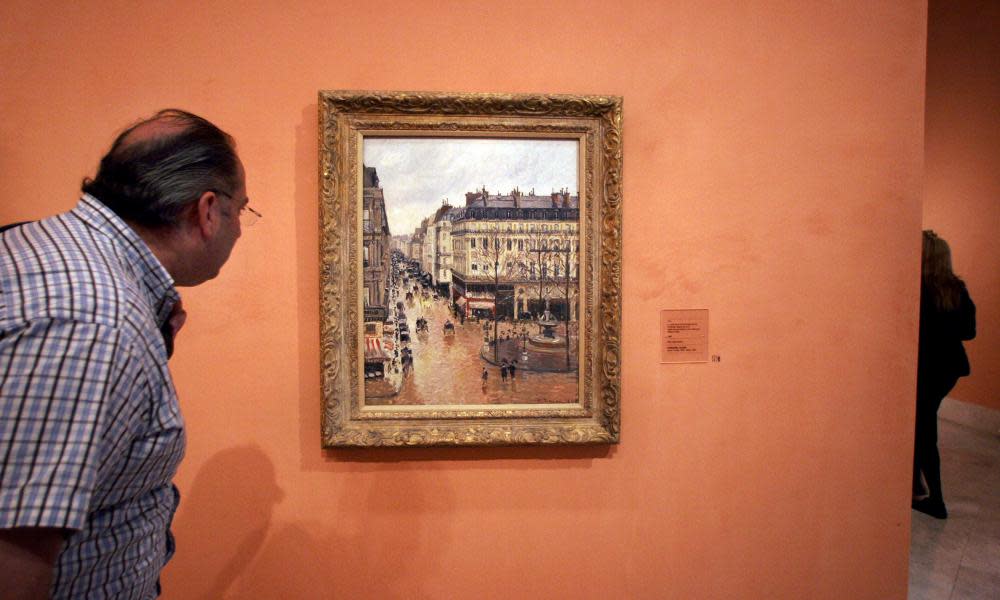Fate of Nazi-looted Pissarro to be decided by US supreme court

Depicting a rainswept Paris street, the Nazi-looted painting has long hung on the walls of one of Madrid’s top art museums. Its fate is now in the hands of the highest court in the US, in a case that has long pitted the Spanish institution against the heirs of Jewish refugees.
At the centre of the US supreme court hearing, set to begin on Tuesday, is an 1897 painting by impressionist Camille Pissarro. For decades the piece – titled Rue Saint-Honoré in the Afternoon, Effect of Rain – graced the walls of the Cassirer family homes in Berlin and Munich after it was bought directly from Pissarro’s art dealer.
In 1939, as escalating Nazi oppression made it clear the prominent Jewish family would have to leave Germany or risk death, Lilly Cassirer Neubauer scrambled to find a way to leave. She was told that exit visas could be obtained, but at a cost: the family would have to hand over its prized Pissarro painting.
A Nazi-appointed appraiser offered a paltry $360, paid into a blocked account that the family was unable to access.
Related: Pissarro painting once owned by Bronwen Astor to enter National Gallery
Cassirer later spent years searching for the oil on canvas work, according to her heirs. After concluding it had been lost or destroyed, she accepted $13,000 in reparations from the German government in 1958 but did not waive her right to seek the painting’s return.
More than 40 years later, her grandson Claude discovered that the painting was on display at Madrid’s Thyssen-Bornemisza museum. After Spain rebuffed his request for its return, he sued in his home state of California, setting off a legal battle that has rumbled on for more than 15 years. When Claude died in 2010, his son David took up the claim.
“This has been three generations of the Cassirer family trying to take back what is theirs,” said the family’s attorney, Stephen Zack of the US law firm Boies Schiller Flexner.
The turbulent past of the painting, whose value has been estimated at $30m (£22m), is not contested. “Unlike many cases where there is a dispute about the facts, no one disputes the fact that this painting was owned by the Cassirers and was taken by the Nazis without compensation,” said Zack.
Instead the legal battle – including the question now being put to the supreme court – has centred on whether California or Spanish law should be used to determine the painting’s rightful owner.
The painting changed hands several times before it was bought by Baron Hans Heinrich Thyssen-Bornemisza in 1976. It subsequently passed to Spain in 1993, when a state-backed non-profit foundation paid the baron $338m for much of his collection, to be installed at a museum bearing his name.
In 2015 a California court ruled that ownership of the painting fell under Spanish law, meaning it was property of the museum as per a Spanish clause that defines ownership as six years of uninterrupted possession. The ruling was upheld by an appeals court in 2020.
The Cassirers had asked the courts to apply local law. “Under California law, there’s no possibility of a person getting good title to a stolen piece of property,” said Zack.
The appeal court, however, chided Spain for failing to abide by its “moral commitments” to return art that had been stolen by the Nazis. “It is perhaps unfortunate that a country and a government can preen as moralistic in its declarations, yet not be bound by those declarations. But that is the state of the law,” read the 2020 ruling.
The Thyssen-Bornemisza museum referred all questions to a press note published in October after the US supreme court agreed to hear the case. “At the conclusion of the case … the foundation anticipates that its ownership of the painting – already recognised by the district court and the ninth circuit – will be affirmed,” it said.
The museum highlighted the court’s finding that both the baron and the foundation had bought the piece without knowledge that it had been stolen. “The evidence demonstrated that in 1958, the German government paid the plaintiff’s predecessor, Lily [sic] Cassirer, her requested compensation (the then-fair market value of the painting) to compensate her for her loss,” it added.
The case comes as heirs around the world continue to fight to reclaim some of the 600,000 artworks looted by Hitler’s Germany. In Spain the main governing bodies of the Jewish community have submitted briefs to the court in support of the Cassirer family, describing the years-long wrangle as exacerbating the deep wounds left by the Holocaust.
“Further harm and offence is caused to the Jewish population in Spain when a government-funded institution publicly displays and claims rightful ownership over an artistic work looted by the Nazis during the Holocaust,” the Jewish Community of Madrid and the Federation of Jewish Communities in Spain said in their submission.
Bernardo Cremades Román, one of the attorneys representing the organisations, contrasted Spain’s quiet, steadfast refusal to return the painting with the country’s high-profile effort to ease the path of citizenship for the descendants of Jews expelled from Spain in the late 15th century. “I think Spain is trying to put a good face out there.”
Reluctance to heed the claim also clashes with Spain’s status as a signatory on the Washington principles, a 1998 agreement pledging to return artwork confiscated by the Nazis to its rightful owners or provide restitution, he noted.
“It’s the right thing to do,” said Cremades Román. “If you see someone that’s been stripped of his or her property illegally, the right thing to do is to return that property. Regardless of whether it’s of Jewish nature or not.”

 Yahoo Movies
Yahoo Movies 
